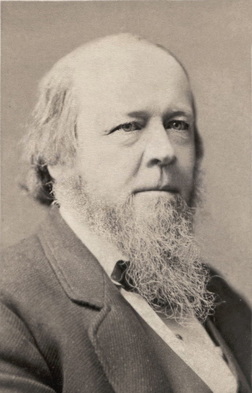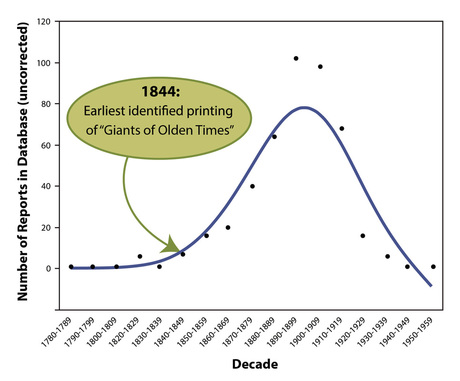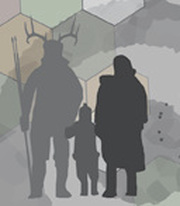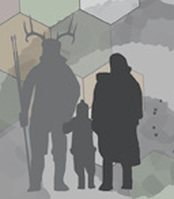When I read through Le Cat's address, I immediately recognized many of his descriptions of "giants" from an article that appeared numerous times in American newspapers in the 1800s. Versions of the article, with headlines such as "Giants of Olden Times" and "There Were Giants In Those Days," were printed at least from the 1840s through the 1890s. I stumbled across versions of the story repeatedly as I was collecting accounts for my database.
 Benjamin Silliman, Jr.
Benjamin Silliman, Jr. Before I talk about why Silliman, Jr., was reportedly lecturing about giants, I wanted to show you how closely the information attributed to him follows the content of Le Cat's address. Below I have transcribed an 1847 article in Scientific American (Vol. 2, Issue 30, pg. 238) (in purple) and provided some corresponding passages from the printing of Le Cat's address in the 1810 Encyclopedia Britannica (in green in brackets). I've bolded the passages of the Scientific American article that are direct copies or close paraphrases of Le Cat's address:
"In one of his recent lectures, Professor Silliman, the younger, alluded to the discovery of the skeleton of an enormous lizard, measuring upwards of eighty feet. From this fact the Professor inferred, as no living specimen of such gigantic magnitude has been found, that the species of which it is the representative has greatly degenerated. The verity of position, he rather singularly endeavors to enforce by an allusion to the well known existence of giants in olden times. The following list furnishes the data on which this singular hypothesis is based:
The giant exhibited at Rouen in 1336, the Professor says, measured over 18 feet.
Gorapius saw a girl who was ten feet high.
The body of Grostes was eleven and a half feet high. [Original reads: The body of Orestes, according to the Greeks, was eleven feet and a half.]
The giant Galbara, brought from Arabia to Rome, under Claudius Caesar, was near ten feet high.
Funnman [a Scotsman], who lived in the time of Eugene II, [king of Scotland,] measured eleven feet and a half.
The Gavalier Scrog, in his voyage to the Peak of Teneriffe, found in one of the caverns of that mountain, the head of Gnnuch, which had eighty teeth, and it was supposed that his body was not less than fifteen feet long. [Original reads: The chevalier Scory, in his voyage to the peak of Teneriffe, says, that they found in one of the sepulchre caverns of that mountain the head of a Guanache which had 80 teeth, and that the body was not less than 15 feet long.]
The giant Ferragus, slain by Orlando, nephew to Charlemagne, was 18 feet high.
In 1814, near St Germain, was found the tomb of the giant Isorent, who was no less than twenty feet high.
In 1590, near Rouen, was found a skeleton whose skull held a bushel of corn, and whose body must have been eighteen feet long. [Original reads: In Rouen, in 1509, in digging in the ditches near the Dominicans, they found a stone-tomb containing a skeleton whose skull held a bushel of corn, and whole shin bone reached up to the girdle of the tallest man there, being about four feet long, and consequently the body must have been 17 or 18 feet high.]
Platorious saw at Lucerne, the human bones of a subject nineteen feet long. [Original reads: Platerus, a famous physician, declares, that he saw at Lucerne the true human bones of a subject which must have been at least 19 feet high.]
The giant Bacart was twenty two and a half feet high; his thigh bones were found in 1703 near the banks of the river Moderi. [Original reads: Valence in Dauphine boasts of possessing the bones of the giant Bucart, tyrant of the Vivarais, who was slain by an arrow by the count De Cabillon his vassal. The Dominicans had a part of the shin-bone, with the articulation of the knee, and his figure painted in fresco, with the inscription, showing that his giant was 22 feet and a half high, and that his bones were found in 1705, near the banks of the Morderi . . .]
In 1613, near a castle in Dauphine, a tomb was found thirty feet long, twenty wide, and eight feet high, on which was cut on a gray stone, the words "Keutolochus Rex." The skeleton was found entire twenty five and a half feet long, ten feet across the shoulders and five feet deep from the breast bone to the back. [Original reads: January 11, 1613, some masons digging near the ruins of a castle in Dauphine, in a field which (by tradition) had long been called the giant's field, at the depth of 18 feet discovered a brick tomb 30 feet long, 12 feet wide, and 8 feet high; on which was a grey stone, with the Theutobochus Rex cut thereon. When the tomb was opened, they found a human skeleton entire, 25 feet and half long, 10 feet wide across the shoulders, and five feet deep from the breastbone to the back. . . .]
Near Mazarino, in Sicily, in 1516, was found the skeleton of a giant thirty feet high. His head was the size of a hogshead, and each of his teeth weighed five ounces.
Near Palermo, in Sicily, in 1548, was found the skeleton of a giant thirty feet long, and another thirty three feet high, in 1550.
We have no doubt that there were "giants in those days" and perhaps Nature was more prolifice in producing them that at present. But the history of giants, during the olden time, is not more remarkable than that of dwarfs. Large men and small are common now-a-days."
Aside from the obvious textual borrowing, one thing that is immediately noticeable is the number of typos in the Scientific American article: "Grostes" instead of "Orestes," "Scrog" instead of "Scory," several dates wrong, etc. Similar typos appear in much later versions of the story (in at least one version of the story from 1891, six years after Silliman's death, the story is attributed to a lecture by a Professor J. A. Williams). The persistence of some old typos reinforces the idea that, once the story entered the American media, it was simply echoed back and forth from newspaper to newspaper for decades. It would be a great "telephone game" study to collect the versions of the story and trace out how/where errors originated, persisted, changed, and multiplied through time and across space. It would also be great to have quantitative to data to see how the printing of the story correlates with the rise and fall of the "giant" craze and perhaps other events or trends in 19th century American history (e.g., the waxing and waning of religious movements, reactions to Darwinian evolution, the emergence of paleontology, etc.).
 Tally of number of "giant" reports by decade in my database as it currently stands (n = 449). Some of the counts will decrease when I add a provision for not counting multiple stories associated with the same primary account.
Tally of number of "giant" reports by decade in my database as it currently stands (n = 449). Some of the counts will decrease when I add a provision for not counting multiple stories associated with the same primary account. That still doesn't address exactly where the original story came from. Was it really from a lecture by Benjamin Silliman, Jr.? Did this eminent scholar really just copy a section out of the Encyclopedia Britannica? I doubt it. I haven't yet been able to find another account of Silliman's original lecture, if indeed there ever was one. But I doubt he actually delivered all that information in a "lecture." The information on giants in the story seems to be presented as a warrant for the past existence of an eighty foot lizard (the skeleton of which presumably belonged to a dinosaur). In other words, evidence for the past existence of giant humans (which we "know" from both fossils and the Bible) is used to argue that giant animals also existed; the smaller size of both animals and humans today is the product of degeneration. (This is a fascinating reversal of the argument I often hear today from modern giant enthusiasts that "there were giant animals in the past, so why not giant humans?") I wonder if dinosaurs, rather than giants, was really the topic of Silliman's lecture.
If that's true, I think it more likely that a reporter was the plagiarist. Given all the typos in even early versions of the "Giants of Olden Times" story, I can imagine some reporter somewhere, rather than Silliman, hurriedly copying text from the Encyclopedia Britannica to fill up column inches. Maybe Silliman gave a lecture about a dinosaur skeleton and invoked the existence of human "giants" in the past, not a controversial position at the time, to convince a skeptical audience that giant animals could have existed in the past also. And maybe he even made reference to some version of Le Cat's address. And maybe a reporter thought the giants angle was more interesting to his audience than the dinosaur one (given the history of the article, he would have been correct). I really don't know.
It would be really interesting to find some more pieces to this puzzle and figure out how this original story got into circulation in the American press. Maybe there is more about Silliman out there - where he lectured, what he talked about. Or maybe there is an earlier version of the story that will provide more clarity. As far as shelf life, the "Giants of Olden Times" story had a long one (how many other newspaper stories get reprinted over the course of 50 years?). And that shelf life seems to have corresponded fairly closely to the heyday of the "giants" craze in North America. That's worth some more work to figure out.


 RSS Feed
RSS Feed
